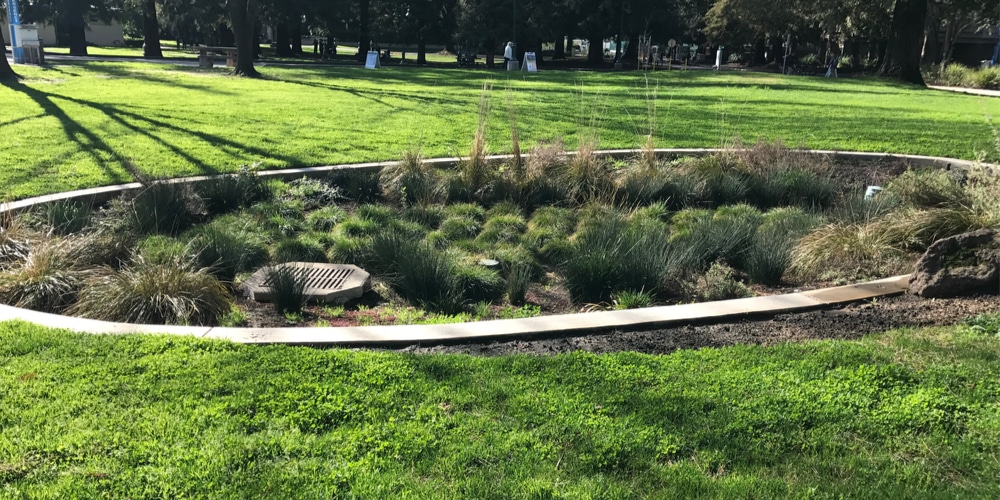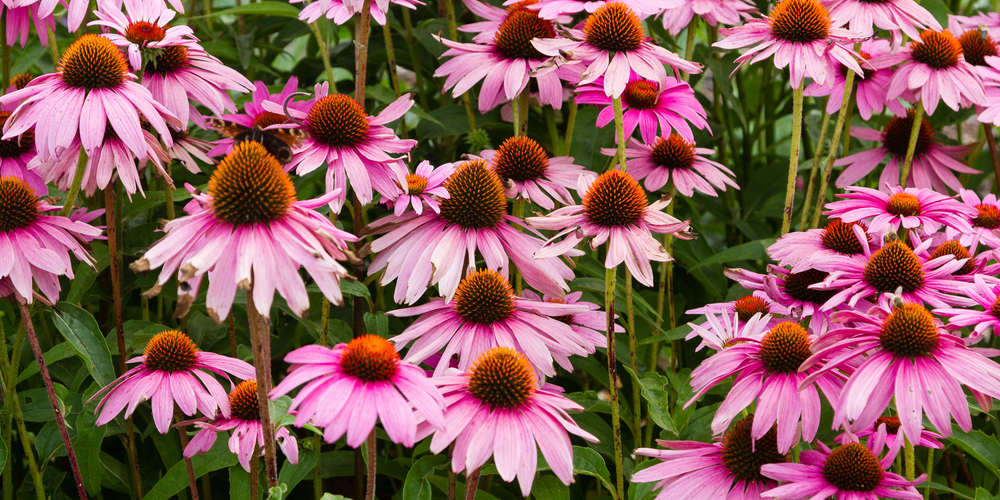Rain Gardens: 101
A rain garden is an innovative feature you can add to your landscape to optimize water usage and enhance your garden’s environmental friendliness.
Benefits of Rain Gardens
Environmental Impact: Rain gardens are beneficial as they reduce runoff pollution, thereby contributing to cleaner streams, lakes, and rivers.
Water Conservation: They allow rainwater to be absorbed into the ground, which replenishes local aquifers.
Habitat Creation: By using native plants, you can provide a habitat for local wildlife like birds and pollinators.
Aesthetic Appeal: Rain gardens add beauty to landscapes with their diverse plant life and can increase property value.
Rain Garden Basics
Design: A typical rain garden is a shallow, constructed depression filled with deep-rooted native plants and grasses.
Function: It is designed to temporarily hold and soak in rainwater runoff that flows from roofs, driveways, patios, or lawns.
Filtration: Rain gardens filter pollutants from runoff water before it enters the water system or is absorbed into the ground.
Site Selection Criteria
Proximity to Buildings: Your rain garden should be at least 10 feet away from structures to prevent water infiltration issues.
Topography: Ideal locations are slightly higher ground upstream from areas prone to ponding.
Slope: Ensure the site has a gentle slope not exceeding 12 percent away from any buildings for optimal water flow.
Soil Composition: Ideal rain garden soils include sandy, loam, or clay types. Soil percolation is crucial for proper absorption and filtration.
Sizing: The size of your rain garden depends on the area of impervious surface draining into it and must also consider the distance from a downspout.
Design and Planning
Creating a successful rain garden involves careful design and planning to ensure that it is both functional and aesthetically pleasing. You’ll need to consider the size and depth of your garden, as well as drainage solutions that affect its efficiency.
Size and Depth Considerations
- Proper Sizing: Your rain garden should be proportionate to the area of impervious surface (like roofs or driveways) it serves. A general guideline is that your garden should be about 20% the size of the runoff area.
- Depth Factors: Aim for a depth of 4-8 inches. This allows for optimal water infiltration while providing enough soil depth for plant roots.
Incorporating Drainage Solutions
- Slope Analysis: Ensure a slope of 1-12% away from your foundation to prevent water from seeping towards your building. To gauge this:
- Place stakes at the upper and lower ends of the proposed site.
- Tie a string at the base of the upper stake.
- Measure the height from the ground to the string at the lower stake to calculate the slope.
- Soil Permeability: Conduct a simple infiltration test by filling a hole with water and observe the drainage time. If water remains longer than 48 hours, consider amending soil with a mix of sand, compost, and topsoil.
- Building a Berm: On the downhill side of the garden, construct a berm using stones and spare soil to create a barrier, ensuring the water pools to an optimal depth of about 6 inches before infiltrating.
Plant Selection
Selecting the right plants for your rain garden ensures healthy growth and effective water management. Keep in mind that native species are well-suited to Illinois’s climate, requiring less maintenance, and providing natural habitats for local wildlife.
Native Plants for Illinois Rain Gardens
Native plants are the cornerstone of a resilient rain garden. Here are some top recommendations:
- For Sun:
- Purple Coneflower (Echinacea purpurea): Thrives in full sun, attracts pollinators.
- Black-Eyed Susan (Rudbeckia hirta): Adapts well to various conditions, offers bright yellow blooms.
- For Shade:
- Palm Sedge (Carex muskingumensis): Suited for moist woodlands, provides texture.
- Jack-in-the-Pulpit (Arisaema triphyllum): Grows in light shade, adds unique floral interest.
Plants for Wet Areas
Your rain garden will have zones that remain wet for longer periods after rainfall. Consider these plants:
- Blue Flag Iris (Iris virginica): Offers striking blue flowers, can withstand standing water.
- Swamp Milkweed (Asclepias incarnata): Beloved by butterflies, provides pink to mauve flowers.
Plants for Dry Areas
Not all areas of a rain garden are perpetually wet. For the drier edges, these species are robust choices:
- Little Bluestem (Schizachyrium scoparium): Tolerates dry soil, offers year-round interest.
- Prairie Dropseed (Sporobolus heterolepis): Features fine foliage and a pleasant aroma when in bloom.
Installation Process
Creating a rain garden involves careful planning and execution. Your key focus areas are preparing the soil effectively and selecting along with implementing the right planting techniques.
Soil Preparation
Before planting, it’s crucial to ensure your soil is prepared to support a healthy rain garden. Begin by assessing the drainage capability of the proposed site. Perform a drainage test—simply dig a hole, fill it with water, and observe how long it takes to drain. Ideal rain garden soil should drain within 24 hours. Adjust soil composition if necessary by incorporating organic matter such as compost to improve drainage and fertility.
Planting Techniques
When it comes to planting your rain garden:
- Choose Native Plants: Select plants native to Illinois that are adapted to the wet and dry cycles of a rain garden.
Plant Type Examples Perennials Swamp milkweed, Joe-Pye weed, Coneflowers Grasses Switchgrass, Northern Sea Oats Shrubs Red osier dogwood, Buttonbush - Arrangement: Plant the most moisture-tolerant plants at the center or the lowest part of the garden. Plants that require less water should be placed around the edges or on mounds within the garden.
- Spacing: Give plants enough space to reach their full size. Overcrowding can hinder growth and doesn’t aid in water absorption.
- Mulching: After planting, apply a layer of mulch to conserve moisture, regulate soil temperature, and reduce weeds. Use shredded hardwood or leaf mulch for best results.
- Watering: Initially, you will need to water the plants regularly until they establish themselves. Once established, rain gardens generally require minimal watering.
Maintenance and Care
Rain gardens are an investment in your landscape that foster water conservation and support local ecosystems. Proper maintenance and care are essential for ensuring the vitality and effectiveness of your rain garden in Illinois.
Watering and Irrigation
Initially, your rain garden plants will require consistent watering to establish deep root systems, particularly in the first few weeks after planting. Once established, rain gardens are designed to utilize natural rainfall, but during prolonged dry spells, supplemental watering may be necessary. Here’s how to water effectively:
- First Year: Water your plants twice a week unless there is sufficient rain.
- Established Gardens: Water only during extended periods without rain, typically once a week.
Adjust your watering schedule based on weather conditions, and always aim to mimic natural rainfall patterns to encourage deeper root growth.
Seasonal Upkeep Tips
Proper care throughout the seasons is crucial for a thriving rain garden.
Spring:
- Clear any accumulated debris from the previous season.
- Replace mulch as needed to maintain a 2-3 inch layer.
- Divide or thin out overgrown perennials to maintain plant health and garden aesthetics.
Summer:
- Monitor for weeds and remove them promptly.
- Observe plant health and look for signs of drought stress, such as wilting or discolored leaves.
Fall:
- Cut back perennials after they have gone dormant.
- Remove any fallen leaves that could smother plants or hinder water infiltration.
Winter:
- Inspect the garden structure for any damage.
- Note any areas where improvements could be made for the following year.
Frequently Asked Questions
In this section, you’ll find targeted answers to common inquiries about establishing a rain garden in Illinois, with specifics on native plants, design, soil preparation, urban challenges, design templates, and cost considerations.
What are the best native plants for creating a rain garden in Illinois?
For your Illinois rain garden, consider native plants such as Swamp Milkweed, Purple Coneflower, and Blue Flag Iris due to their adaptability to the local climate and soil conditions. These species thrive in wet environments and support local ecology.
How should I design a rain garden appropriate for the Midwest climate?
Designing a rain garden for the Midwest climate involves incorporating a slight slope away from your home. Also, ensure it’s at least 10 feet from foundations for proper water absorption and reduced flooding risk. Opt for a mixture of deep and shallow-rooted natives tailored to seasonal precipitation.
What are the essential steps to prepare the soil for a rain garden in Illinois?
Start by testing your soil to determine its type and drainage capability. Amend heavy clay soils with compost to improve infiltration. Ensure the chosen site has a slope of 1-12 percent away from your home for effective drainage.
What are some potential challenges to maintaining a rain garden in Chicago’s urban landscape?
Urban settings may present challenges such as compacted soils, limited space, and heavy pollution. Urban rain gardens require diligent design to combat these challenges, such as selecting pollutant-tolerant plants. Also, ensure there is enough space for water collection and infiltration.
Can you suggest any rain garden design templates suitable for Illinois Zone 5?
While there aren’t universal templates due to varying yard conditions, your rain garden design should allow for native plant biodiversity and efficient water absorption. Consider consulting local extension services or utilizing online resources that take Zone 5’s climate into account.
What is the estimated cost range for professionally designing and installing a rain garden in Illinois?
The cost for professional rain garden design and installation in Illinois can vary widely. It can range from a few hundred dollars for small, DIY projects to several thousand for large, professionally executed gardens.
Costs depend on garden size, complexity, and the choice of plants and materials.

